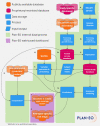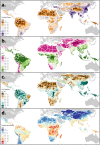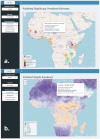The Planetary Child Health & Enterics Observatory (Plan-EO): A protocol for an interdisciplinary research initiative and web-based dashboard for mapping enteric infectious diseases and their risk factors and interventions in LMICs
- PMID: 38412156
- PMCID: PMC10898779
- DOI: 10.1371/journal.pone.0297775
The Planetary Child Health & Enterics Observatory (Plan-EO): A protocol for an interdisciplinary research initiative and web-based dashboard for mapping enteric infectious diseases and their risk factors and interventions in LMICs
Abstract
Background: Diarrhea remains a leading cause of childhood illness throughout the world that is increasing due to climate change and is caused by various species of ecologically sensitive pathogens. The emerging Planetary Health movement emphasizes the interdependence of human health with natural systems, and much of its focus has been on infectious diseases and their interactions with environmental and human processes. Meanwhile, the era of big data has engendered a public appetite for interactive web-based dashboards for infectious diseases. However, enteric infectious diseases have been largely overlooked by these developments.
Methods: The Planetary Child Health & Enterics Observatory (Plan-EO) is a new initiative that builds on existing partnerships between epidemiologists, climatologists, bioinformaticians, and hydrologists as well as investigators in numerous low- and middle-income countries. Its objective is to provide the research and stakeholder community with an evidence base for the geographical targeting of enteropathogen-specific child health interventions such as novel vaccines. The initiative will produce, curate, and disseminate spatial data products relating to the distribution of enteric pathogens and their environmental and sociodemographic determinants.
Discussion: As climate change accelerates there is an urgent need for etiology-specific estimates of diarrheal disease burden at high spatiotemporal resolution. Plan-EO aims to address key challenges and knowledge gaps by making and disseminating rigorously obtained, generalizable disease burden estimates. Pre-processed environmental and EO-derived spatial data products will be housed, continually updated, and made publicly available for download to the research and stakeholder communities. These can then be used as inputs to identify and target priority populations living in transmission hotspots and for decision-making, scenario-planning, and disease burden projection.
Study registration: PROSPERO protocol #CRD42023384709.
Copyright: © 2024 Colston et al. This is an open access article distributed under the terms of the Creative Commons Attribution License, which permits unrestricted use, distribution, and reproduction in any medium, provided the original author and source are credited.
Conflict of interest statement
The authors declare that they have no competing interests.
Figures



Update of
-
The Planetary Child Health & Enterics Observatory (Plan-EO): a protocol for an interdisciplinary research initiative and web-based dashboard for mapping enteric infectious diseases and their risk factors and interventions in LMICs.Res Sq [Preprint]. 2024 Jan 10:rs.3.rs-2640564. doi: 10.21203/rs.3.rs-2640564/v3. Res Sq. 2024. Update in: PLoS One. 2024 Feb 27;19(2):e0297775. doi: 10.1371/journal.pone.0297775. PMID: 36993232 Free PMC article. Updated. Preprint.
Similar articles
-
Updating global estimates of pathogen-attributable diarrhoeal disease burden: a methodology and integrated protocol for a broad-scope systematic review of a syndrome with diverse infectious aetiologies.BMJ Open. 2025 Apr 3;15(4):e093018. doi: 10.1136/bmjopen-2024-093018. BMJ Open. 2025. PMID: 40180367 Free PMC article.
-
The Planetary Child Health & Enterics Observatory (Plan-EO): a protocol for an interdisciplinary research initiative and web-based dashboard for mapping enteric infectious diseases and their risk factors and interventions in LMICs.Res Sq [Preprint]. 2024 Jan 10:rs.3.rs-2640564. doi: 10.21203/rs.3.rs-2640564/v3. Res Sq. 2024. Update in: PLoS One. 2024 Feb 27;19(2):e0297775. doi: 10.1371/journal.pone.0297775. PMID: 36993232 Free PMC article. Updated. Preprint.
-
The Minderoo-Monaco Commission on Plastics and Human Health.Ann Glob Health. 2023 Mar 21;89(1):23. doi: 10.5334/aogh.4056. eCollection 2023. Ann Glob Health. 2023. PMID: 36969097 Free PMC article. Review.
-
Cost of illness for childhood diarrhea in low- and middle-income countries: a systematic review of evidence and modelled estimates.BMC Public Health. 2020 May 5;20(1):619. doi: 10.1186/s12889-020-08595-8. BMC Public Health. 2020. PMID: 32370763 Free PMC article.
-
Mortality by cause for eight regions of the world: Global Burden of Disease Study.Lancet. 1997 May 3;349(9061):1269-76. doi: 10.1016/S0140-6736(96)07493-4. Lancet. 1997. PMID: 9142060
Cited by
-
Updating global estimates of pathogen-attributable diarrhoeal disease burden: a methodology and integrated protocol for a broad-scope systematic review of a syndrome with diverse infectious aetiologies.BMJ Open. 2025 Apr 3;15(4):e093018. doi: 10.1136/bmjopen-2024-093018. BMJ Open. 2025. PMID: 40180367 Free PMC article.
-
Spatial variation in housing construction material in low- and middle-income countries: A Bayesian spatial prediction model of a key infectious diseases risk factor and social determinant of health.PLOS Glob Public Health. 2024 Dec 18;4(12):e0003338. doi: 10.1371/journal.pgph.0003338. eCollection 2024. PLOS Glob Public Health. 2024. PMID: 39693286 Free PMC article.
References
-
- The United Nations General Assembly. Transforming our world: the 2030 Agenda for Sustainable Development. Resolution adopted by the General Assembly on 25 September 2015. 2015. p. A/RES/71/313.
-
- Liu L, Oza S, Hogan D, Chu Y, Perin J, Zhu J, et al.. Global, regional, and national causes of under-5 mortality in 2000–15: an updated systematic analysis with implications for the Sustainable Development Goals. The Lancet. 2016;388: 3027–3035. doi: 10.1016/S0140-6736(16)31593-8 - DOI - PMC - PubMed
-
- Global Burden of Disease Collaborative Network. Global Burden of Disease Study 2019 (GBD 2019) Results. Seattle, United States: Institute for Health Metrics and Evaluation (IHME); 2020.
-
- You D, Hug L, Ejdemyr S, Idele P, Hogan D, Mathers C, et al.. Global, regional, and national levels and trends in under-5 mortality between 1990 and 2015, with scenario-based projections to 2030: A systematic analysis by the un Inter-Agency Group for Child Mortality Estimation. The Lancet. 2015;386: 2275–2286. doi: 10.1016/S0140-6736(15)00120-8 - DOI - PubMed
MeSH terms
Grants and funding
LinkOut - more resources
Full Text Sources
Medical
Research Materials

